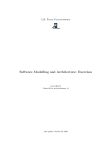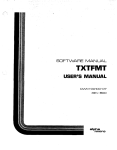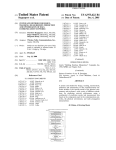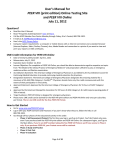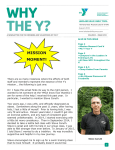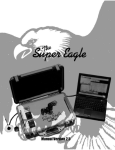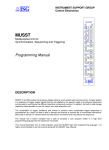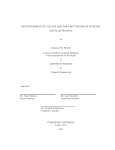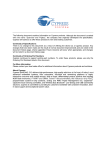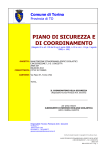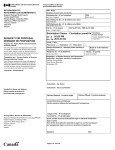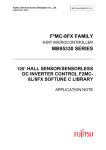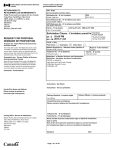Download Method and apparatus for a transportable environmental database
Transcript
US 20040186847A1 (19) United States (12) Patent Application Publication (10) Pub. No.: US 2004/0186847 A1 (43) Pub. Date: Rappaport et al. (54) METHOD AND APPARATUS FOR A TRANSPORTABLE ENVIRONMENTAL DATABASE FOR COMMUNICATIONS NETWORK MANAGEMENT AND ENGINEERING (76) Inventors: Theodore S. Rappaport, Blacksburg, VA (US); Roger R. Skidmore, Blacksburg, VA (US) Correspondence Address: WHITHAM, CURTIS & CHRISTOFFERSON, P.C. 11491 SUNSET HILLS ROAD SUITE 340 RESTON, VA 20190 (US) Sep. 23, 2004 Publication Classi?cation (51) Int. Cl? ..................................................... .. G06F 7/00 (52) Us. 01. ............................................................ ..707/101 (57) ABSTRACT A Building Database Manipulator to build databases for a variety of physical environments including de?nitions of buildings, terrain and other site parameters, by scanning in or rapidly editing data. Raster scans may be entered or object ?les in various formats may be used as input. Detailed information is stored in the draWing database about the object’s location, radio frequency attenuation, color, and other physical information such as electrical characteristics and intersections of the object With the ground, ?oors, (21) Appl. No.: 10/809,687 ceilings, and other objects When objects are formatted in a (22) Filed: Mar. 26, 2004 in nature, but the resulting draWing is a true three-dimen drawing. The formatting process is strictly two-dimensional sional environment. The user sees the three-dimensional Related US. Application Data building structure by altering the vieWs. The resulting data base may be used in a variety of modeling applications, but (63) Continuation of application No. 09/318,841, ?led on is especially useful for engineering, planning and manage May 26, 1999. ment tools for in-building or microcell Wireless systems. 10 Patent Application Publication Sep. 23, 2004 Sheet 1 0f 8 US 2004/0186847 A1 INPUT ExIsTIND ‘01A DATA REMOVE 102A IINNEEDED OBJECTS I FORMAT EXISTING OBJECTS - v_-____ OPTIONAL 103/\AND CREATE-AND FORMAT NEw ' sTART OBJECTS AS NEEDED 4 i ID4/\ VERIFY DRAWING vIEw 3D AND DPDATE DB RENDERING * 106/\ - @(DRTIDNAI) _ _ OF ENVIRONMENT EXPORT DATA > IN APPIIcATIDN 105 READABLE FORMAT FIG.1 Patent Application Publication Sep. 23, 2004 Sheet 2 0f 8 US 2004/0186847 A1 PHOTO [AB if? , Him UH'ii V 1 J ISTOCKRO M ENGI ERNG “H LLLEL THEE-g5 LAB ME. l km L 5 5: Ne. E? vNc VAC. ? VAC. CONFROM E W FEET“ F|G.2 Patent Application Publication Sep. 23, 2004 Sheet 3 0f 8 2 US 2004/0186847 A1 Patent Application Publication Sep. 23, 2004 Sheet 4 0f 8 INPUT CAD US 2004/0186847 A1 /\— 201 DRAWING I REMOVE EXTRANEOUS /\- 202 OBJECTS’ I FORMAT OBJECTS USING DRAWINC/ FORMATTINC COMMANDS I ADJUST PARTITION COLORS + DESCRIPTIONS I VERIFY DRAWING FIG/I N 203 Patent Application Publication Sep. 23, 2004 Sheet 5 0f 8 DRAW ENTITLES US 2004/0186847 A1 /\,2()3 ; ASSIGN PARTITION N204 INFO l VERIFY DRAWING FIG.5 @206 Patent Application Publication Sep. 23, 2004 Sheet 6 0f 8 SH CURRENT‘FLOOR /\- 401 II ATIACH RAsIER. IMAGE (IMPORT) . v , “402 - SCALE IMAGE ~40; VERIFY DRAWING /\_404 FIG.6A sEI CURRENT FLOOR A401 ATTACH RAsIER IMAGE A 402 SCALE IMAGE A403 - I! IRAGE IMAGE A405 I! vERIEY DRAWING A404 US 2004/0186847 A1 Patent Application Publication Sep. 23, 2004 Sheet 7 0f 8 Endpoint . US 2004/0186847 A1 _ ‘ Snops to the closest endpoint of on entity. Selection point snop point FIG.7A mm - Snops to the midpoint of on entity. Selection point snop point FIG.7B Pedrpgndicuiar Selection point 5MP Point F IG.7C Patent Application Publication Sep. 23, 2004 Sheet 8 0f 8 Node _ US 2004/0186847 A1 _ Snaps to ‘<1 point ObjGCt selection and snap points a: FIG.7D Intersection selection , pomt sngp pomt F|G.7E Apparent intersection sngptx pom selection point seIect'ion4/ point " Sep. 23, 2004 US 2004/0186847 A1 METHOD AND APPARATUS FOR A TRANSPORTABLE ENVIRONMENTAL DATABASE FOR COMMUNICATIONS NETWORK MANAGEMENT AND ENGINEERING outdoor large scale Wireless system, or macrocell, Will provide suf?cient coverage throughout a building, or group CROSS-REFERENCE TO RELATED APPLICATIONS Whether indoor Wireless transceivers, or picocells, must be added. The placement of these cells is critical from both a cost and performance standpoint. If an indoor Wireless of buildings (i.e., a campus). Alternatively, Wireless engi neers must determine Whether local area coverage Will be adequately supplemented by other existing macrocells, or [0001] This application is related to concurrently ?led applications Serial No. , entitled “Method and Sys tem for Managing a Real Time Bill of Materials,” ?led by T. S. Rappaport and R. R. Skidmore (Docket 256016AA) and Ser. No. , entitled “Method and System for Auto mated OptimiZation of Antenna Positioning in 3-D,” ?led by T. S. Rappaport and R. R. Skidmore (Docket 256017AA), and copending application Ser. No. 09/221,985, entitled “System for Creating a Computer Model and Measurement Database of a Wireless Communication Network” ?led by T. S. Rappaport and R. R. Skidmore and assigned to a common system is being planned that interferes With signals from an outdoor macrocell, the design engineer must predict hoW much interference can be expected and Where it Will mani fest itself Within the building, or group of buildings. Also, providing a Wireless system that minimiZes equipment infra structure cost as Well as installation cost is of signi?cant economic importance. As in-building and microcell Wireless systems proliferate, these issues must be resolved quickly, easily, and inexpensively, in a systematic and repeatable manner. assignee, the subject matter of Which is incorporated herein [0007] There are many computer aided design (CAD) by reference. products on the market that can be used to design the environment used in one’s place of business or campus. [0002] DESCRIPTION WiSE from Lucent Technology, Inc., SignalPro from EDX, PLAnet by Mobile Systems International, Inc., and TEMS BACKGROUND OF THE INVENTION and TEMS Light from Ericsson are examples of Wireless 1. Field of the Invention or campus is designed only on paper and a database of [0003] The present invention generally relates to database development using computer aided design and, more par ticularly, to manipulating data from any environment in the World (e.g. cities, buildings, campuses, ?oors Within a building, objects in an outdoor setting, etc.) to construct an electronic building database that can be used to generate de?nitions of the user’s building and site parameters and used With Wireless communication system modeling and engineering planning products. [0004] 2. Background Description [0005] As Wireless communications use increases, radio frequency (RF) coverage Within buildings and signal pen etration into buildings from outside transmitting sources has quickly become an important design issue for Wireless engineers Who must design and deploy cellular telephone systems, paging systems, or neW Wireless systems and technologies such as personal communication netWorks or Wireless local area netWorks. Designers are frequently requested to determine if a radio transceiver location, or base station cell site can provide reliable service throughout an entire city, an office, building, arena or campus. A common problem for Wireless systems is inadequate coverage, or a “dead Zone,” in a speci?c location, such as a conference room. It is noW understood that an indoor Wireless PBX (private branch exchange) system or Wireless local area netWork can be rendered useless by interference from nearby, similar systems. The costs of in-building and microcell devices Which provide Wireless coverage Within a 2 kilometer radius are diminishing, and the Workload for RF engineers and technicians to install these on-premises sys tems is increasing sharply. Rapid engineering design and deployment methods for microcell and in-building Wireless systems are vital for cost-ef?cient build-out. [0006] AnalyZing radio signal coverage penetration and interference is of critical importance for a number of rea sons. A design engineer must determine if an existing CAD products. In practice, hoWever, a pre-existing building parameters de?ning the environment does not readily exist. It has been difficult, if not generally impossible, to gather this disparate information and manipulate the data for the purposes of planning and implementation of indoor and outdoor RF Wireless communication systems, and each neW environment requires tedious manual data formatting in order to run With computer generated Wireless prediction models. Recent research efforts by AT&T Laboratories, Brooklyn Polytechnic, and Virginia Tech, are described in papers and technical reports entitled “Radio Propagation Measurements and Prediction Using Three-dimensional Ray Tracing in Urban Environments at 908 MHZ and 1.9 GHZ,” (IEEE Transactions on Vehicular Technology, VOL. 48, No. 3, May 1999), by S. Kim, B. J. Guarino, Jr., T. M. Willis III, V. Erceg, S. J. Fortune, R. A. Valenzuela, L. W. Thomas, J. Ling, and J. D. Moore, (hereinafter “Radio Propagation”); “Achievable Accuracy of Site-Speci?c Path-Loss Predic tions in Residential Environments,” (IEEE Transactions on Vehicular Technology, VOL. 48, No. 3, May 1999), by L. PiaZZi and H. L. Bertoni; “Measurements and Models for Radio Path Loss and Penetration Loss In and Around Homes and Trees at 5.85 GhZ,” (IEEE Transactions on Communi cations, Vol. 46, No. 11, November 1998), by G. Durgin, T. S. Rappaport, and H. Xu; “Radio Propagation Prediction Techniques and Computer-Aided Channel Modeling for Embedded Wireless Microsystems,” ARPA Annual Report, MPRG Technical Report MPRG-TR-94-12, July 1994, 14 pp., Virginia Tech, Blacksburg, by T. S. Rappaport, M. P. Koushik, J. C. Liberti, C. Pendyala, and T. P. Subramanian; “Radio Propagation Prediction Techniques and Computer Aided Channel Modeling for Embedded Wireless Microsys tems,” MPRG Technical Report MPRG-TR-95-08, July 1995, 13 pp., Virginia Tech, Blacksburg, by T. S. Rappaport, M. P. Koushik, C. Carter, and M. Ahmed; “Use of Topo graphic Maps With Building Information to Determine Antenna Placements and GPS Satellite Coverage for Radio Detection & Tracking in Urban Environments,” MPRG Technical Report MPRG-TR-95-14, Sep. 15, 1995, 27 pp., Sep. 23, 2004 US 2004/0186847 A1 Virginia Tech, Blacksburg, by T. S. Rappaport, M. P. Koushik, M. Ahmed, C. Carter, B. NeWhall, and N. Zhang; “Use of Topographic Maps With Building Information to models, measurement devices, and optimiZation methods Determine Antenna Placement for Radio Detection and [0012] According to the invention, pre-eXisting data for a Tracking in Urban Environments,” MPRG Technical Report MPRG-TR-95-19, November 1995, 184 pp., Virginia Tech, Blacksburg, by M. Ahmed, K. Blankenship, C. Carter, P. Koushik, W. NeWhall, R. Skidmore, N. Zhang and T. S. Rappaport; “A Comprehensive In-Building and Microcellu lar Wireless Communications System Design Tool,” MPRG-TR-97-13, June 1997, 122 pp., Virginia Tech, Blacksburg, by R. R. Skidmore and T. S. Rappaport; “Pre dicted Path Loss for Rosslyn, Va.,” MPRG-TR-94-20, Dec. 9, 1994, 19 pp., Virginia Tech, Blacksburg, by S. Sandhu, P. Koushik, and T. S. Rappaport; “Predicted Path Loss for Rosslyn, Va., Second set of predictions for ORD Project on Site Speci?c Propagation Prediction” MPRG-TR-95-03, Mar. 5, 1995, 51 pp., Virginia Tech, Blacksburg, by S. Sandhu, P. Koushik, and T. S. Rappaport. These papers and technical reports are illustrative of the state of the art in site-speci?c propagation modeling and shoW the dif?culty in obtaining databases for city environments, such as Rosslyn, Virginia. While the above papers describe a research com parison of measured vs. predicted signal coverage, the Works do not demonstrate a systematic, repeatable and fast meth odology for creating an environmental database, nor do they report a method for visualiZing and placing various envi ronmental objects that are required to model the propagation of RF signals in the deployment of a Wireless system in that environment. SUMMARY OF THE INVENTION [0008] It is therefore an object of the invention to provide a method for manipulating draWings and electronic ?les to build databases for use in planning the positioning of components and for designing, installing and optimiZing a Wireless communication system. In the method, raster scanned images of an environment may be entered or object ?les in various formats may be used as input to de?ne an environment in Which a Wireless system is to be imple mented. Detailed information about the location, radio fre quency attenuation, color, and other physical information of an object, such as intersections of the object With the ground, has value and is a marked improvement over present day systems. desired environment may be scanned in, traced or translated from another electronic format as a short-cut to provide a partial de?nition for the environment. The partial or empty environment is then re?ned using a specialiZed draWing program to enter entities and objects that fully de?ne the environment in terms of ?oors, partitions, obstructions, and other data required for engineering planning of a Wireless communications netWork in the environment. The input data are generally tWo dimensional (2D) representations of the environment. When ceiling height, elevation above sea level, or partition height data is entered, the draWing may then automatically be vieWed in three-dimensions (3D). This 3D representation enables the design engineer to visually verify any parameters incorrectly entered. The de?nition of the environment, or draWings, maps or other data are veri ?ed and the design engineer is automatically prompted to enter missing or inconsistent information. Once the draW ing(s) have been veri?ed, the data de?ning the environment may be used by a variety of tools, models, Wireless propa gation prediction methods, measurement products or opti miZation procedures that require information about an envi ronment’s terrain levels, physical make up, and speci?c location of ?oors, Walls, foliage or other obstruction and partition structures. Anything that impedes or otherWise affects the propagation of radio Wave energy must be con sidered When predicting the performance of a Wireless communication system in the environment, and the present methodology provides a simpli?ed mechanism for collect ing and editing this information in a readily usable form. The method for constructing and manipulating an indoor or outdoor environment is useful not only for Wireless com munication designers, but may also be useful for other applications, as Well. BRIEF DESCRIPTION OF THE DRAWINGS [0013] The foregoing and other objects, aspects and advantages Will be better understood from the folloWing detailed description of a preferred embodiment of the inven tion With reference to the draWings, in Which: ?oors, ceilings, and other objects in the environment is [0014] stored in a draWing database. the invention; [0009] It is another object of the invention to provide a computeriZed draWing in a true three-dimensional environ ment based on input data Which is strictly tWo-dimensional [0015] FIG. 2 is a representation of a typical building ?oor plan; [0016] FIG. 3 is a representation of a raster image of a in nature. The user sees the three-dimensional draWing house; structure on a computer display by altering the vieWs. [0017] FIG. 1 is a How diagram of the general method of FIG. 4 is How diagram of a method for generating draWings from pre-eXisting computer aided design (CAD) [0010] It is another object of the invention to provide the resulting database of the inventive method in a form easily draWings; used in a variety of modeling applications, especially forms useful for engineering, planning and management tools for Wireless systems. [0018] [0011] It is another object of the invention to support a universal method for creating and editing and transporting FIG. 5 is a How diagram of a method for creating a draWing Without pre-eXisting information; [0019] FIG. 6A is a How diagram of a method for gen erating draWings from pre-eXisting raster images to be used only With distant dependent Wireless system performance environmental databases for Wireless communication sys prediction models; tem design, prediction, measurement and optimiZation. A systematic and automated method for producing a 3-D environmental database that is reproduceable and transport able betWeen many different Wireless system prediction [0020] FIG. 6B is a How diagram of a method for gener ating draWings from pre-eXisting raster images to be used With any number of Wireless system performance prediction models; and Sep. 23, 2004 US 2004/0186847 A1 [0021] FIGS. 7A through 7F show examples of methods for snapping an object to a grid, or other desired location on a drawing. DETAILED DESCRIPTION OF A PREFERRED EMBODIMENT OF THE INVENTION is important. The user is prompted to affirmatively declare that each piece of desired data has been entered and veri?ed for proper format. If there are missing data, the user may then return to step 103 to enter additional necessary objects before running the veri?cation procedure in function block 104, again. This step provides automatic veri?cation guid ance and prompts the user With feedback. [0022] The present invention is used to build databases for use With modeling and engineering planning and automated design products. The current embodiment permits repeat able, reproduceable computer representation that may be transported or exported into many standard ?le formats and is designed speci?cally for use With the SitePlanner suite of products available from Wireless Valley Communications, [0026] Once the draWing has been veri?ed, the data is stored in the database in function block 106 or can be exported for use in an application that does not read directly from the database. This specially formatted data includes all information necessary to describe the building, site or cam pus environment. Inc. of Blacksburg, Va. HoWever, it Will be apparent to one skilled in the art that the method could be practiced With other products either noW knoWn or to be developed in the future. (SitePlanner is a trademark of Wireless Valley Com [0027] While the above description generally describes munications, Inc.) With the SitePlanner suite of products. Therefore, a detailed example of hoW each step is performed Will use this embodi [0023] Referring noW to the draWings, and more particu larly to FIG. 1, there is shoWn a How diagram for the method of the present invention. In order to build a specially formatted database that contains data necessary and suf? cient for input into an engineering model, a de?nition of the desired environment must ?rst be built. First, existing data is entered into the system database in function block 101. This data may be in a variety of formats, as described in detail later. Because this existing data may be in a format Which embodies unnecessary additional data, legends, map layers or text, unneeded objects are removed from the database in function block 102. The existing objects are then formatted and embellished With additional information in the method of the invention, a more detailed description folloWs. The current embodiment, Building Database Manipulator (BDM), has been designed to operate integrally ment as a foundation for discussion. HoWever, it should be understood that the BDM could be used With other Wireless communications propagation models (eg ray-tracing mod els or statistical models), other Wireless prediction tools (e.g., Lucent Technologies WiSE, EDX SignalProTM, Eric sson TEMS, MSI PLAnet), or measurement tools noW available (e.g., a Wireless LAiN transceiver, a spectrum analyZer, or any Wireless measurement device such as a ZK Celltest 836 or a Berkeley Varitronics Champ receiver), or developed in the future. (BDM is a trademark of Wireless Valley Communications, Inc. SignalPro is a Trademark of EDX. PLAnet is a trademark of Mobile Systems Interna function block 103. Objects may include simple lines, tional.) representing Walls or the sides of buildings or they may be [0028] Wireless prediction modeling softWare Will typi polygons or polylines Which represent trees, foliage, build ings, or other obstructions. An arbitrary number of objects cally utiliZe a site-speci?c database format, meaning that the database is speci?c to the area/environment it represents. may be draWn, traced, or moved using CAD commands Which have a speci?c representation. In the preferred buildings and terrain, properly scaled and positioned in embodiment, each object or the group of objects saved in a ?le format knoWn as “.DWG” Which is developed by AutoDesk, Inc. HoWever, it Would be apparent to one skilled in the art hoW to practice this invention With other applica tions and tools using other formats. If additional objects are needed to describe the environment, they are also added to the database here. In the event that there is no pre-existing data, and the database must be built from scratch, the process may begin at this point, skipping steps 101 and 102. [0024] Once the data has been entered, the user may optionally display the 2D data as a 3D representation in function block 105. The 3D vieW can be displayed at any time after entering height data, at the user’s discretion. [0025] Once the user has entered all of the data, a veri? cation of the draWing may be performed in function block 104. At this point the process does a step-by-step analysis of the environment de?ned in the database to determine Whether any data is missing. The invention provides an interactive feedback to the engineer and prompts the user as to Where scaling and alignment are required, etc. While the preferred embodiment is described in detail, it should be evident to one skilled in the art that alternative methods such This database can be thought of as being a collection of three-dimensional (3D) space relative to one another. In turn, each building is a collection of the ?oors that it houses (e.g., a nine story building has nine ?oors). FIG. 2 shoWs a typical building ?oor plan as it may be entered into the database. Each ?oor is a collection of obstructions/parti tions. An obstruction/partition is anything that impedes or otherWise affects the propagation of radio Wave energy, and thus must be considered When predicting the performance of a Wireless communication system in the environment. For example, concrete Walls, brick Walls, sheetrock Walls, doors, WindoWs, large ?ling cabinets, and many others are all obstructions/partitions. At the same time, a large croWd of people, varying terrain, or foliage could also be considered obstruction/partitions. [0029] The SitePlanner products, speci?cally, utiliZe a specially formatted vector database format, meaning that it consists of lines and polygons rather than individual pixels (as in a raster format). The arrangement of lines and poly gons in the database corresponds to obstructions/partitions in the environment. For example, a line in the database could represent a Wall, a door, or some other obstruction/partition in the modeled environment. as totally automated veri?cation may be possible. Because [0030] any engineering planning tool requires a speci?c set of information to operate optimally and ef?ciently, veri?cation ries. The user may de?ne different categories of obstruc Obstructions/partitions are classi?ed into catego tions/partitions. A category is de?ned by a textual descrip Sep. 23, 2004 US 2004/0186847 A1 less In-Building Personal Communication System Design,” tion (e.g., “External Brick Walls”), a vertical height (i.e., hoW tall is the Wall), a color (to quickly distinguish it from entities belonging to other categories While vieWing the (IEEE Transactions on Vehicular Technology, VOL. 43, No. 4, November 1994), by S. Y. Seidel and T. S. Rappaport; drawing), and electromagnetic properties (discussed in fur “Antenna Effects on Indoor Obstructed Wireless Channels ther detail later). The category to Which a given draWing entity (Where an entity is either a line or polygon) has been assigned de?nes the type of obstruction/partition it repre sents. For example, if a given line has been assigned to the user-de?ned category of “Sheetrock Walls,” then it shares and a Deterministic Image-Based Wide-Band Propagation Model for In-Building Personal Communication Systems,” (International Journal of Wireless Information Networks, the characteristics given by the user to all other entities Vol. 1, No. 1, 1994), by C. M. P. Ho, T. S. Rappaport and M. P. Koushik; and “Interactive Computation of Coverage Regions for Wireless Communication in Multi?oored Within that category throughout the entire database draWing. Indoor Environments,” (IEEE Journal on Selected Areas in The process of either creating neW entities or changing the Communication, Vol 14, No. 3, April 1996), by M. A. category to Which the entity belongs is a simple point-and PanjWani, A. L. Abbott and T. S. Rappaport, “Measurements click process using a mouse or other positioning device, by linking entities to a particular user de?ned category of and Models for Radio Path Loss and Penetration Loss In and Around Homes and Trees at 5.85 GhZ,” (IEEE Transactions partitions. The preferred embodiment alloWs the physical, on Communications, Vol. 46, No. 11, November 1998), by G. Durgin, T. S. Rappaport, and H. Xu, and previously cited references, all of Which are hereby incorporated by refer electrical, and aesthetic characteristics of entities of the same category to be individually or collectively edited. Category designation is carried out by assigning a particular numerical value to the ?eld of each entity, Wherein the ?eld is speci?ed as part of the draWing database. [0031] From the standpoint of radio Wave propagation, each obstruction/partition in an environment (i.e., each entity in the draWing, or the equivalent thereof), has several electromagnetic properties that directly affect it. When a radio Wave signal intersects a physical surface, several things occur. Acertain percentage of the radio Wave re?ects off of the surface and continues along an altered trajectory. A certain percentage of the radio Wave penetrates through the surface and continues along its course. A certain per centage of the radio Wave is scattered once it strikes the surface. The electromagnetic properties given to the obstruc tion/partition categories, When used in conjunction With knoWn electromagnetic theory, de?ne this interaction Within the environment. Each category has parameters that include an attenuation factor, surface roughness, and re?ectivity. The attenuation factor determines the amount of poWer a radio signal loses When it penetrates through an entity of the given type. The re?ectivity determines the amount of the radio signal that is re?ected from the entity (as opposed to penetrating through it). The surface roughness provides information used to determine hoW much of the radio signal is scattered upon striking an entity of the given type. [0032] As mentioned above, the parameters given to each category fully de?ne the entities contained Within it. Alter ing the parameters of a category directly affects all entities assigned to it. This greatly simpli?es the tedium of database creation for site-speci?c modeling. [0033] The method used to predict and optimiZe antenna positioning in a desired environment uses a number of models, such as those described in the papers: “Interactive Coverage Region and System Design Simulation for Wire less Communication Systems in Multi-?oored Indoor Envi ronments, SMT Plus,”IEEE IC UPC ’96 Proceedings, by R. R. Skidmore, T. S. Rappaport, and L. Abbott; “Achievable Accuracy of Site-Speci?c Path-Loss Predictions in Residen tial Environments,” (IEEE Transactions on Vehicular Tech nology, VOL. 48, No. 3, May 1999), by L. PiaZZi and H. L. Bertoni (hereinafter “Achievable Accuracy”); “Wireless Propagation in Buildings: A Statistical Scattering Approach,” (IEEE Transactions on Vehicular Technology, VOL. 48, No. 3, May 1999), by D. Ullmo and H. U. Baranger; “Site-Speci?c Propagation Prediction for Wire ence. Some simple models are also brie?y described in “SitePlanner 3.16 for WindoWs 95/98/NT User’s Manual” (Wireless Valley Communications, Inc. 1999), hereby incor porated by reference. It Would be apparent to one skilled in the art hoW to apply other models to this method. [0034] In order to build a database that can be used in site-speci?c modeling, as done, for instance, in SitePlanner, or in equivalent programs noW knoWn or later developed, or similarly in other applications, one can either build each entity from scratch or start With a full or partial de?nition of the environment in some format. The present invention offers many solutions to ease the incorporation of previously draWn or scanned images of building ?oor plans to accom plish step 101 of the method, as shoWn in FIG. 1. A Wide variety of pre-eXisting formats such as a paper map, an electronic map, a blueprint, and eXisting CAD draWing, a bitmap image, or some other representation, are used to obtain environmental information. Most commonly, this information is available in some form of electronic building blueprint or map information and in the case of buildings, is often supplied one ?oor at a time. That is, a building blueprint usually involves a separate blueprint or other piece of information for each building ?oor. TWo possible formats for this information are raster and vector. The present invention eXtracts environmental data from both formats. One skilled in the art Would see hoW both raster and vector data (e.g., USGS raster terrain data With vector building overlays) could be combined using the present invention. [0035] Raster draWings or maps are collections of indi vidually colored points (or “piXels”) that, When vieWed as a Whole, form a picture representation of the environment. FIG. 3 shoWs a photograph of a house 10 made up of a series of colored piXels to represent the appearance of a house (appearing here in black and White). A raster image or map references the piXels in a speci?c grid rather than vectors. Therefore, raster images do not contain detailed information about objects. [0036] The present invention alloWs raster images to be copied, moved, or clipped. Using the present invention, one can modify an image With grip modes, adjust an image for contrast, clip the image With a rectangle or polygon, or use an image as a cutting edge for a trim. EXamples of raster formats processed by the preferred embodiment of the present invention include, but are not limited to, WindoWs Bitmaps (BMP), Joint Photographic EXperts Group format Sep. 23, 2004 US 2004/0186847 A1 (JPEG), Graphical Interchange Format (GIF), Tagged-Im adjusted, the 3D structure or the draWing database is altered age File Format (TIFF), Targa format (TGA), PICT, and Postscript. Raster drawings of any type may be converted automatically, as appropriate. This is a major improvement into vector draWings, or other vector data based represen over other 3D techniques simply from a speed and ease of use point of vieW. It is much easier to construct a building tations. The process involves using the imported raster draWing (Which is really just an image) as a backdrop, and in 2D using lines and polygons Whose vertical dimension is handled automatically, as in the present invention, than to then tracing over it With a mouse or other positioning device, model the same building in 3D using slanted or vertical planes, as is done in other systems, such as suggested in the and adding neW entities (lines and polygons), to generate a formatted database/draWing. “Radio Propagation” and “Achievable Accuracy” papers, [0037] Vector draWings are collections of individual lines and polygons. Examples of vector formats include cited above. The 3D vieW enables the user to verify the building structure (i.e., that the vertical dimension of an AutoCAD draWing ?les (DWG), Autodesk DraWing obstruction/partition category has not been inadvertently Exchange Because vector ?les draWings (DXF), and already WindoWs consistMeta?les of lines and poly is ultimately useful When vieWing Wireless prediction or gons, converting them into a format used by the present invention is straightforWard. In the preferred embodiment, vector draWings are converted into BDM format draWings by simply loading them, selecting lines and/or polygons Within the draWing, and then assigning the selected entities speci?ed incorrectly) and provides a unique perspective that measurement data for evaluation of the performance of the communication system being modeled. [0043] Once an environment has been speci?ed and de?ned as objects, and a visual veri?cation of the 3D to a given category. draWing is complete, a full veri?cation of this de?nition is performed in step 104, as shoWn in FIG. 1. The engineer or [0038] When using pre-existing data formats, it is prob designer selects the Final DraWing Check procedure to able that the map or draWing Will contain information that is ensure that all of the steps necessary to create a fully unneeded for the modeling and prediction steps. Therefore, functional model of the desired building environment have one should remove unneeded objects from the draWing, as been correctly performed. These steps include ensuring that shoWn in step 102 of FIG. 1. the modeled environment is properly scaled and that the separate ?oors of the building are visually aligned in 3D [0039] In addition to importing images and draWings, a collection of commands that permit users to draW neW ?oor plans to accomplish step 103 of the method is provided. Multiple ?oor plans may be combined into three-dimen sional, multi-?oored draWing databases for use in the method, also in step 103. space. Certain draWing structures and information can also be automatically detected. For example, the number of ?oors in a given building, the number and types of obstruction/ partition categories and the entities assigned to each type, Whether or not the user has already veri?ed the draWing previously, and What (if any) activity has been done to the [0040] During the process of creating and formatting draWing database by the other SitePlanner-tool suite mem building databases, one may vieW the current draWing in 3D, as shoWn in step 105 of FIG. 1. Each obstruction/partition category has an associated height parameter that de?nes the bers can be automatically detected and reported to the user. vertical dimension of each entity in the given category. By creating a neW entity of a given category or converting an entity from or betWeen categories, the vertical dimension of the neW entity is automatically adjusted to match that speci?ed for the category. Thus, if the invention processes a 2D vector draWing (i.e., a draWing With individually select able lines and polygons), selecting an entity and assigning it to a given category carries out the conversion betWeen 2D and 3D automatically. If the invention processes a raster draWing (i.e., a bitmap or similar format draWing that consists of individual colored pixels), the draWing can be imported and “traced over”, Where With the creation of each neW entity, the category again de?nes the vertical dimension given to the entity. [0041] Each building ?oor can itself be thought of as a category that encapsulates the obstruction/partition catego ries de?ned by the user. Each ?oor of a building has an associated ceiling height. Alternatively, entire buildings may be represented With a building height. For the case of a multi?oor building, the ceiling heights given to each ?oor in a building de?nes the vertical separation betWeen them. Thus, the ceiling height parameter of a given ?oor is used to correctly position, vertically in space, each entity located on the ?oor relative to the entities located on other ?oors of the [0044] To obtain Wireless system performance predictions using data generated With the present invention, as disclosed in the concurrently ?led, copending application Ser. No. (Docket 256016AA) and Ser. No. (Docket 256017AA), one preferably uses the present method for the preparation of building databases. Depending on the chosen Wireless system propagation or performance prediction model, important information is needed such as physical distances, partition locations, ?oor locations, and the num bers of ?oors and partitions. Standard architectural draW ings, like scanned images, do not contain the necessary database information. Therefore, building a veri?ed data base for use in the selected Wireless system propagation or performance prediction model is essential to ensure the best results. [0045] Computer Aided Design (CAD) programs create vector graphics, made of lines and curves de?ned by math ematical objects called vectors. Vectors describe graphics according to their geometric characteristics. For example, a Wheel in a vector graphic is made up of a mathematical de?nition of a circle draWn With a certain radius, thickness, color, and speci?c location. A user can move, resiZe, or change the color of the Wheel Without losing the quality of the graphic. building. [0046] The present invention utiliZes the vector informa tion of imported maps, draWings or electronic images and [0042] Once the height of a given obstruction/partition category and/or the ceiling height of a given ?oor is complex 3-D representations and vector based databases. ?le formats, as Well as information input by users, to build Sep. 23, 2004 US 2004/0186847 A1 The preferred embodiment utilizes the drawing commands from AutoCAD, a product of AutoDesk, Inc. of San Rafael, Calif. It Would be apparent to one skilled in the art that any other vectoriZed draWing tool, either noW knoWn or to be invented could be used as an alternative in the practice of the [0057] Aspect—Sets the grid to a different spacing in X and Y directions. [0058] Cursor Snap command—This command prompts the user With “Snap spacing or ON/OFF/ mation in the draWing database about the object’s location, attenuation factor, color, and other physical and electrical Aspect/Rotate/Style <0.5000>:” [0059] Spacing—Activates Snap mode With the speci?ed value. [0060] ON—Activates Snap mode using the current snap grid resolution, rotation, and style. information such as re?ectivity, or intersections of the object [0061] present invention. The process of inputting and converting the environmental information into a database is referred to as formatting. The present invention facilitates the format ting of objects in a draWing, and also stores detailed infor With ?oors, ceilings, and other objects. [0047] The present invention may scan and format envi ronmental information if a vector draWing of the environ ment does not exist. If formatted vector draWings do exist, the method of the invention provides many Ways for these draWings to be formatted into a useful format. Generally, tWo “starting points” exist When Working With vector draW ings. These starting points are brie?y discussed in the folloWing bulleted list. [0048] Starting With a previously draWn (CAD) ?oor plan, and [0049] Starting from scratch. [0050] In order to create a vectoriZed draWing of a desired environment, it is desired to utiliZe a number of draWing tools. The present method provides the user With a Wide range of commands Which have been crafted for rapid database creation and manipulation, as described beloW. Many of these commands rely on speci?c combinations of AutoCAD draWing commands Which are sequentially executed Without the user having to knoW the speci?c CAD OFF—Turns off Snap mode but retains the values and modes. [0062] Aspect—Speci?es differing X and Y spacing for the snap grid. This option is not available if the current snap style is Isometric. [0063] Rotate—Sets the rotation of the snap grid With respect to the draWing and the display screen. The user speci?es a rotation angle betWeen —90 and 90 degrees. A positive angle rotates the grid counter clockWise about its base point. A negative angle rotates the grid clockWise. [0064] Base point <current>: The user speci?es a point [0065] Rotation angle ~current>: The user speci ?es an angle [0066] Style—The user speci?es the format of the Snap grid, Which is standard or isometric. [0067] Standard—Displays a rectangular grid that commands. It should be apparent to one skilled in art that the is parallel to the XY plane of the current Universal Coordinate System of the draWing database. X and Y spacing may differ. method for creating draWings, as described beloW, could be [0068] Isometric—Displays an isometric grid, in practiced With other products either noW knoWn or to be Which the grid points are initially at 30- and ISO-degree angles. Isometric snap can be rotated but cannot have different Aspect values. developed in the future. [0051] VieW Formatted Information command—This command invokes a list box that contains a list of formatted ?oors in a draWing. [0069] Object Selection Snap command—This com mand alloWs the user to select points in the draWing. One should note that When more than one check box [0052] Hide Formatted Information command—This command alloWs a user to hide partitions that have been previously formatted. [0053] option is selected, the invention applies the selected snap modes to return a point closest to the center of the aperture box. VieW Unformatted Information command— [0070] The Snap procedure is especially useful in draWing This command Works in a similar manner as the the ?oors of the environment When tracing raster images and draWing from scratch. FIGS. 7A through 7F illustrate the various snapping procedures Which are used by AutoCAD VieW Formatted Information command. A list box of available layers in the draWing that are not formatted layers is displayed. [0054] Toggle Orthogonal DraW On/Off command— With the default cursor snap setup, ORTHO mode (ON) constrains cursor movement to horiZontal and vertical directions (90 degrees). [0055] Display Grid command—This command alloWs the user to specify grid spacing, or to turn on/off snap and aspect options. It also alloWs the user to specify the spacing value betWeen grid lines. The user may turn the grid on or off. and knoWn to those skilled in the art. For instance, the Endpoint option snaps to the closest endpoint of an entity as shoWn in FIG. 7A. The Midpoint option snaps to the midpoint of an entity as shoWn in FIG. 7B. The Perpen dicular Node Nearest Intersection option snaps to a point perpendicular to an entity as shoWn in FIG. 7C. The node option snaps to a point object as shoWn in FIG. 7D. The Nearest option snaps to the nearest point on an entity. The Intersection option snaps the intersection of tWo or more entities as shoWn in FIG. 7E. The Apparent Intersection option includes tWo separate snap modes: Apparent Inter section and Extended Apparent Intersection. The user can [0056] Snap—Sets the grid spacing to the current snap interval. locate Intersection and Extended Intersection snap points While running Apparent Intersection object snap mode. Sep. 23, 2004 US 2004/0186847 A1 [0071] Apparent Intersection snaps to the apparent inter section of tWo entities that do not intersect in 3D space, but might appear to intersect onscreen. Extended Apparent Intersection snaps to the imaginary intersection of tWo objects that Would appear to intersect if the objects Were the art. The veri?cation process can also be fully automated, Without requiring user interaction. The preferred embodi ment currently provides for the folloWing steps: [0081] extended along their natural paths, as shoWn in FIG. 7F. [0072] The Quick option snaps to the ?rst snap-point on the ?rst object found. Quick must be used in conjunction With other object snap modes. [0073] Other useful commands are described beloW: [0074] ticular object in the draWing. [0082] Align Building Floors assists in aligning ?oors in a draWing after the different ?oors have been assembled in the draWing. [0083] ShoW Distance BetWeen Points command— This command prompts the user to select tWo points in a draWing, after Which the distance the points are Entities Ceiling Height alloWs the user to adjust the heights of ceilings in either meters or feet. [0084] Set Partition Labels and Colors permits the user to set and modify the partition labels and the display. [0075] Break/Ungroup Scale DraWing is used to scale a draWing to the proper siZe based on the knoWn siZe of a par colors of the partitions. The height may also be modi?ed. If the partitions already exist in a draWing, command—This command alloWs the user to ungroup and break apart the user can use this command to globally change the color of partitions or the partition’s name. objects. [0076] Purge command—In addition to the graphic objects used by the present method, there are several [0085] Set Origin of Building Coordinate System types of non-graphical objects that are stored in be stored in the draWing database. This point is important for assembling draWings so that the point can automatically align the draWings. alloWs the user to specify a reference point Which to draWing ?les. These objects have descriptive desig nations associated With them; for example blocks, layers, groups, and dimension styles. In most cases the user names objects as they are created, and they can later be renamed. Names are stored in symbol tables. When a named object is speci?ed on the command line or selected from a dialog box, the name and associated data of the object is referenced in the symbol table. Unused, unreferenced named objects can be purged from a draWing at any time during an editing session. Purging reduces draWing siZe, and therefore, the memory requirements for Working With the draWing. Objects that are refer enced by other objects cannot be purged. All objects [0086] Set Environmental/Path Loss Parameters alloWs modi?cation of partition labels, path loss parameters, and electrical characteristics such as attenuation parameters. [0087] Create Boundary creates an invisible bound ary around a draWing to guide the predictive models so that the predictions/calculations are reasonably bounded in the space Within the database. [0088] may be purged at once, or the user can select a category of object to purge such as: Linetypes, Text Styles, Dimension Styles, Multiline Styles, Blocks, and Shapes. [0077] DraWing Utilities command—This command [0078] [0089] The Remove-Purge Unnecessary DraWing Infor alloWs the user to audit the draWing or recover from mation command must be selected manually to ensure a corrupted draWing. appropriate purging of unused draWing objects. Referring noW to FIG. 4, if the user starts With a previously draWn CAD draWing, the folloWing steps outline typical procedures for formatting draWings. Methods for implementing this outline are discussed beloW. [0079] First, the CAD draWing is input in function block 201. The user then decides What extraneous draWing objects to remove (e.g., doors, labels, borders, draWing scales, stairs, etc.) in function block 202. Remaining objects are formatted using draWing commands, as described above, in function block 203. Partition colors and descriptions are adjusted, as desired in function block 204. After formatting all objects, the draWing is veri?ed in function block 206. [0080] Create Legend alloWs the user to enter perti nent information about a draWing, and gives the user options to siZe the legend relative to the current WindoW and options to add additional information to the legend such as a partition color legend, a contour color legend, and a measurement data color legend. In the preferred embodiment, veri?cation is an automated sequential process that takes the user through a series of procedures, as listed beloW, to determine that all necessary data has been entered consistently. In alternative embodiments, the order of the procedures and functions of each procedure can be altered, merged, expanded, modi?ed, or even omitted depending on the judgment of one skilled in [0090] If the format de?nition of the database is modi?ed, it Would be apparent to one skilled in the art hoW to change the method of veri?cation to accommodate these modi?ca tions. It Would also be apparent to one skilled in the art hoW to modify and extend existing draWing or CAD packages to perform the method of the invention. [0091] Referring to FIG. 5, if the user starts from scratch and intends to implement a complete vector database, for matting a draWing Will consist, only of draWing entities in function block 203, and assigning partition information to the draWing in function block 204. [0092] In the preferred embodiment, partitions are draWn and existing partitions can be modi?ed. Any entity or draWing object can be converted into a formatted partition on a particular ?oor. The type of partition of a previously formatted entity can be modi?ed. The ?oor on Which a particular formatted object resides can also be changed. Objects Will still remain visible in the draWing after con verting them to partitions on other ?oors. These objects may Sep. 23, 2004 US 2004/0186847 A1 partition information by selecting objects in the drawing The scanned image is “traced” by the user to draW partitions and other obstructions prior to veri?cation in function block requesting partition information in the command menu. A text WindoW containing the returned information regarding draWing from scratch, except that the scanned image pro be hidden at the user’s discretion. A user can display 404. This method is similar to draWing a vector based the object’s type, location, length, and electrical attributes vides a trace guide. The end result is a draWing that can be such as attenuation factor is displayed. used by all Wireless system prediction models, including [0093] environment, they must be assembled before ?nal veri?ca those Which rely on knoWledge of the physical environment. [0100] Adistinct advantage of the present invention is that tion. An automated procedure combining several separate single ?oor draWings into one multi-?oored draWing may be draWings and stored in the database. The ceiling heights (or If more than one draWing is used to de?ne the executed. [0094] Finally, the draWing is veri?ed in function block 206, as described above. This veri?cation Will automatically make corrections to the legend that may have been corrupted after assembling several draWings into one ?le. Methods for formatting a draWing from scratch are discussed beloW. [0095] Referring noW to FIG. 6, a method is shoWn to format a raster image into a draWing that can be used for a true three-dimensional environment is rendered from the building heights) that are speci?ed are used to determine the vertical height of any partitions found on a given ?oor. A height is de?ned for a category of partitions and this de?nes the object’s height for each entity in that category. This is done automatically during the formatting process. Thus, even though the formatting process Was strictly tWo-dimen sional in nature, When the formatting of a draWing is completed, the resulting draWing is a true three-dimensional environment. The user can see the three-dimensional build modeling. Because computer monitors represent images by ing structure by altering the vieWpoint. displaying them on a grid, both vector and raster images are [0101] displayed on screen as small squares or dots knoWn as ?oor draWings that can later be assembled into one multi pixels. Raster images only consist of a rectangular grid of pixels. [0096] The image ?le formats supported by the present invention include the most common formats used in major technical imaging application areas: computer graphics, document management, and mapping and geographic infor mation systems (GIS). The present invention determines the ?le format from the ?le contents, not from the ?le extension. Thus, additional formats could be added easily by including The present invention can be used to create single ?oored draWing or it can be used to create one or several multi-?oored draWings all at once. After creating a single ?oor, all entities that are not partitions should be removed from the draWing. Thus, if a raster image Was used as a reference for tracing partitions, it should be erased once the tracing is complete. The method provides assistance to the user to distinguish betWeen partition and non-partition objects. Typically, objects referred to as formatted objects are partition objects and objects referred to as unformatted their translation parameters in the method. objects are non-partition objects. [0097] [0102] The ?nal stage of formatting a draWing involves several veri?cation steps. These steps are automatically Often times only a scanned image of a ?oor plan is available, as shoWn in FIG. 2. Auser can insert a raster or bitmapped black and White, 8-bit gray, 8-bit color, or 24-bit color image ?le into the draWing. Users can insert images in a variety of formats, currently including BMP, TIF, RLE, JPG, GIF, and TGA. More than one image can be displayed in any vieWport, and the number and siZe of images is not limited. Once the raster image is no longer needed, the user can detach the image from the draWing. sequenced, as described above. Before each step is per formed, the user is asked Whether that step has yet been performed. If the user ansWers “Yes”, then that step is skipped and the user is asked about the next step. OtherWise, the current step is performed and the user is prompted for any necessary information. When all steps have been com pleted, the draWing is saved. Unnecessary draWing informa tion should then be purged. The formatted draWing should then be saved again. [0098] There are tWo preferred Ways that a scanned image can be formatted. The ?rst approach for formatting a raster image is shoWn in FIG. 6A. First the current ?oor is set in [0103] function block 401. In a neW draWing, this creates the Wireless communication system engineering, planning and necessary ?oor layers based upon the user’s selection. Therefore, any neWly draWn partitions Will reside on the current ?oor as chosen by the user. Then the image is imported in function block 402 and scaled in function block 403. Finally the draWing is veri?ed in function block 404. Since this draWing originally did not contain any vector management tools for in-building or microcell Wireless system, for instance as described in the concurrently ?led and copending application: Ser. No. , entitled “Method and System for Managing a Real Time Bill of Materials, ?led by T. S. Rappaport and R. R. Skidmore (Docket 256016AA; Ser. No. , entitled “Method and This formatted draWing can noW be used in any number of applications. Speci?cally, it may be used in objects, the draWing database consists only of an image of System for Automated OptimiZation of Antenna Positioning the given environment that has been scaled to the proper dimensions. It does not contain information With regard to in 3-D,” ?led by T. S. Rappaport and R. R. Skidmore physical objects Within the environment. Depending on the application, this may be sufficient for engineering use, for instance, When a Wireless propagation prediction model only Model and Measurement Database of a Wireless Commu nication NetWork” ?led by T. S. Rappaport and R. R. uses distance and does not rely on knoWledge of the physical environment. Skidmore. It may also be useful in any other number of applications that require a 3-D model of a building, campus [0099] The second approach for formatting a raster image or urban environment. is shoWn in FIG. 6B. This method is similar to the method shoWn in FIG. 6A With the addition of function block 405. [0104] While the invention has been described in terms of a single preferred embodiment, those skilled in the art Will (Docket 256017AA); and copending application Ser. No. 09/221,985, entitled “System for Creating a Computer Sep. 23, 2004 US 2004/0186847 A1 recognize that the invention can be practiced With modi? cation Within the spirit and scope of the appended claims. Having thus described our invention, What We claim as neW and desire to secure by Letters Patent is as follows: 1. A method for manipulating data from any environment in the World to construct a database that can be used to generate de?nitions of the user’s physical environment including buildings, terrain and other site parameters, com prising the steps of: (a) creating and formatting a plurality of objects de?ning an environment of ?oors, Walls, partitions, buildings, building complexes or compounds, terrain, foliage or other sites or obstructions; (b) verifying the suf?ciency of said plurality of objects to ensure a useful de?nition of said environment and notifying a user of results of said veri?cation of suf? ciency; and (c) generating a set of formatted data in a form transport able to and usable by an engineering planning model or other application. 2. A method as recited in claim 1, said method further comprising at least one of the steps: (d) inputting existing data, vectors or draWing objects, said existing data, vectors or draWing objects either partially or fully describing said environment; and (e) removing extraneous draWing objects to simplify said de?nition of said environment; three-dimensional vieW may be performed at any time after at least one of said plurality of objects has been created. 5. A method as recited in claim 4, Wherein said-rendering step includes the step of selecting a three-dimensional vieW of a selected perspective of said environment. 6. A method as recited in claim 1, Wherein step (a) further comprises the step of adjusting partition colors, and physical and electrical descriptions of said partitions. 7. A method as recited in claim 1, Wherein said formatted data de?nes said environment and each said object is asso ciated With at least one of the group consisting of a speci?c location in said environment, an attenuation factor, a color, a height, a surface roughness value, and a re?ectivity value. 8. A method as recited in claim 1, Wherein step (b) automatically prompts a user to verify that each piece of necessary information to de?ne said environment has been added to said de?nition of said environment before execut ing the veri?cation of said each piece of necessary infor mation, and if said user ansWers in the negative, prompts said user to enter missing information before proceeding. 9. A method as recited in claim 1, Wherein said formatted data comprises at least one vectoriZed draWing of said environment. 10. An apparatus for manipulating data from any envi ronment in the World to construct a database that can be used to generate de?nitions of the user’s physical environment including buildings, terrain and other site parameters, com prising: means for creating and formatting a plurality of objects de?ning an environment of ?oors, Walls, partitions, Wherein steps (d) and (e) may be performed before or after step (a), if data exists that fully or partially de?nes said buildings, building complexes or compounds, terrain, environment. 3. A method as recited in claim 2, Wherein said existing data is in the form of raster ?les, or in the form of vector ?les, Wherein said raster ?les are selected from the group means for generating a set of formatted data in a form consisting of WindoWs Bitmaps (BMP), Joint Photographic Experts Group format (JPEG), Graphical Interchange For mat (GIF), Tagged-Image File Format (TIFF), Targa format (TGA), PICT, and Postscript, and Wherein said vector ?les are selected from the group consisting of AutoCAD (DWG), AutoDesk (DXF) and WindoWs MetaFile 4. A method as recited in claim 1, said method further comprising the step of rendering a three-dimensional vieW of said environment, Wherein said step of rendering a foliage or other sites or obstructions; and transportable to and usable by an engineering planning model or other application. 11. An apparatus as recited in claim 10, further compris ing a means for verifying the suf?ciency of said plurality of objects to ensure a useful de?nition of said environment and notifying a user of results of said veri?cation of suf?ciency. 12. An apparatus as recited in claim 10, further compris ing a means for inputting existing data, vectors or draWing objects, said existing data, vectors or draWing objects either partially or fully describing said environment. * * * * *



















